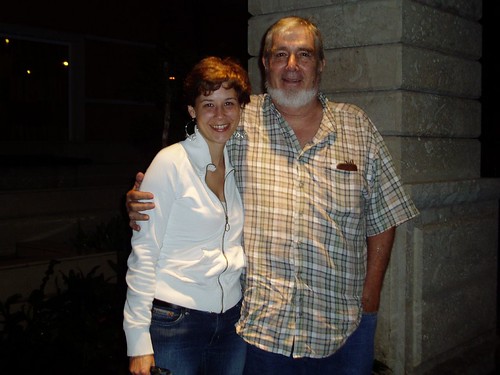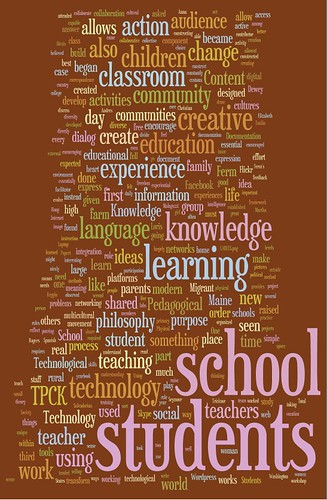Wednesday, November 25, 2009
Saturday, November 21, 2009
a partner in teaching
I have been working with a dear friend who teaches at PUCMM in Santiago, Dominican Republic. He asked for suggestions on how to incorporate technology and I suggested they make videos or podcasts to re-create the history they are learning in his Dominican History class.
In exchange for my expertise, I asked him to be a part of my teaching on the Ning. He's also my contact for the DR2010 trip--world, meet Luis Midence, someone who really is amazing.

I can explain how we met some other time, it's an interesting story, but for now just say we've been friends for 7 years.
His students, nineteen- and twenty-year-old Dominicans, are on step two/producción right now, and I am thrilled at their engagement. The topic of their video is Trujillo, and the idea is to share the perspectives of people not in the DR during the time of prolific events of his dictatorship. So some interesting perpectives happening--when Luis sent me scripts to look at, I saw they had Haitians and Kreyol, and reports from Miami, the Canary Islands, and Spain. I am so curious now as to the video portion and how they will portray these people--a Dominican lens, if you will!
We connected several times in the past 3 months, on Skype and google talk, to talk about his class project. His participation and enthusiasm helped me define my steps for multimedia and I borrow heavily from Marco Torres, except I added a step to his original Four P's of Multimedia. This is designed for Spanish students.
Planificación
teacher
share rubrics
share student samples
students
research
storyboard logical flow of visual
script logical flow of audio
source citation
Producción
equipment
location
recording
editing
Presentación
share
teacher sees it first
in class
at home
on the web (closed networks)
Evaluación
completed rubric
comment from teacher
comments from peers
self-evaluation by student
Reflexión
what was your role?
what did you learn?
what would you change?
In exchange for my expertise, I asked him to be a part of my teaching on the Ning. He's also my contact for the DR2010 trip--world, meet Luis Midence, someone who really is amazing.

I can explain how we met some other time, it's an interesting story, but for now just say we've been friends for 7 years.
His students, nineteen- and twenty-year-old Dominicans, are on step two/producción right now, and I am thrilled at their engagement. The topic of their video is Trujillo, and the idea is to share the perspectives of people not in the DR during the time of prolific events of his dictatorship. So some interesting perpectives happening--when Luis sent me scripts to look at, I saw they had Haitians and Kreyol, and reports from Miami, the Canary Islands, and Spain. I am so curious now as to the video portion and how they will portray these people--a Dominican lens, if you will!
We connected several times in the past 3 months, on Skype and google talk, to talk about his class project. His participation and enthusiasm helped me define my steps for multimedia and I borrow heavily from Marco Torres, except I added a step to his original Four P's of Multimedia. This is designed for Spanish students.
Planificación
teacher
share rubrics
share student samples
students
research
storyboard logical flow of visual
script logical flow of audio
source citation
Producción
equipment
location
recording
editing
Presentación
share
teacher sees it first
in class
at home
on the web (closed networks)
Evaluación
completed rubric
comment from teacher
comments from peers
self-evaluation by student
Reflexión
what was your role?
what did you learn?
what would you change?
Labels:
dr2010,
nings,
personallearningcommunity,
plc,
quisqueya,
Spanish,
student filmmakers
Friday, November 20, 2009
Learning Styles
Cross-posted at Dirigo Spanish. Da ning, baddabing.
Recently my students took a learning style inventory. I took it as well. The data showed the main learning styles of my class are aural, social, and verbal.

Here are my results.

Here is my main learning style descriptor:
Recently my students took a learning style inventory. I took it as well. The data showed the main learning styles of my class are aural, social, and verbal.

Here are my results.

Here is my main learning style descriptor:
If you have a strong social style, you communicate well with people, both verbally and non-verbally. People listen to you or come to you for advice, and you are sensitive to their motivations, feelings or moods. You listen well and understand other’s views. You may enjoy mentoring or counseling others.
You typically prefer learning in groups or classes, or you like to spend much one-on-one time with a teacher or an instructor. You heighten your learning by bouncing your thoughts off other people and listening to how they respond. You prefer to work through issues, ideas and problems with a group. You thoroughly enjoy working with a “clicking” or synergistic group of people.
You prefer to stay around after class and talk with others. You prefer social activities, rather than doing your own thing. You typically like games that involve other people, such as card games and board games. The same applies to team sports such as football or soccer, basketball, baseball, volleyball, baseball and hockey.
Common pursuits and phrases
Some examples of pursuits that people with a strong social style may follow include counseling, teaching, training and coaching, sales, politics, human resources, and others.
As with people with the logical style, you are more likely to use phrases that reflect your dominant style out of physical, aural and visual styles. Here are some other phrases you may also use:
* Let’s work together on this.
* We can work it out.
* Tell me what you are thinking.
* Help me understand this.
* Let’s pull some people together to discuss.
* Let’s explore our options.
Tuesday, November 17, 2009
hierarchy of needs
Monday, November 16, 2009
good good things
I don't talk about photojournalism enough. I am afraid if I talk about how awesome it is, it might disappear.
Photojournalism.
Is.
Awesome.
These kids amaze me. Really, they do. A lot.
Photojournalism.
Is.
Awesome.
These kids amaze me. Really, they do. A lot.
conferences
Two days worth of conferences. I did student-led for freshmen.
Of 24 slots, 20 were filled with parents and kids.
It made for two busy nights. For the record? Monday night conferences?
Not great timing for teachers. We work late on a Monday and people assume we have the whole week to recover. Suuure.
* *
My favorite moment of the night: "I notice you seem apprehensive about speaking in class."
"I'm afraid I will say something stupid."
A huge smile from me: "Oh honey, everyone is going to sound stupid at first."
and then
"I once told people I was pregnant when I was fifteen. They took one look and said, no you're not."
and then
"I will laugh with you, not at you."
and finally
"Language is fun!"
.....lucky for me, they were overtired enough to laugh and smile and go along for the ride.
I really like student-led conferences.
Of 24 slots, 20 were filled with parents and kids.
It made for two busy nights. For the record? Monday night conferences?
Not great timing for teachers. We work late on a Monday and people assume we have the whole week to recover. Suuure.
* *
My favorite moment of the night: "I notice you seem apprehensive about speaking in class."
"I'm afraid I will say something stupid."
A huge smile from me: "Oh honey, everyone is going to sound stupid at first."
and then
"I once told people I was pregnant when I was fifteen. They took one look and said, no you're not."
and then
"I will laugh with you, not at you."
and finally
"Language is fun!"
.....lucky for me, they were overtired enough to laugh and smile and go along for the ride.
I really like student-led conferences.
Sunday, November 15, 2009
More data
My brain has been very much wrapped around visualization of data. To date, I am looking at Google Gapminder. And my brother pointed me to this gem. (You really gotta click to see his lovely diagram.)
David McCandless writes:
David McCandless writes:
* Information needs to be interesting (meaningful & relevant) and have integrity (accuracy, consistency).
* Design needs to have form (beauty & structure) and function (it has to work and be easy to use).
You may disagree. I welcome your input. I may not have got it right.
Something surprised me about doing this though.
In information design, it seems, if you have just two elements, you get something tolerable and cool. i.e.
* integrity + form = eye candy
* interestingness + function = experiment
(I’m not entirely sure about these combos)
But if you combine three elements without the fourth, things suddenly FAIL:
* interesting subject, solid information, looks great, but is hard to use = useless.
* amazing data, well designed, very easy to read but isn’t that interesting = boring
What do you think? This is a work in progress. Can you help me shape this a bit? Have I missed anything?
Sunday, November 8, 2009
reminding myself
Wednesday, November 4, 2009
polciy makers versus practitioners
What is our philosophy of teaching with technology?
What are we doing with these tools?
What are we doing with these tools?
Tuesday, November 3, 2009
Subscribe to:
Posts (Atom)


